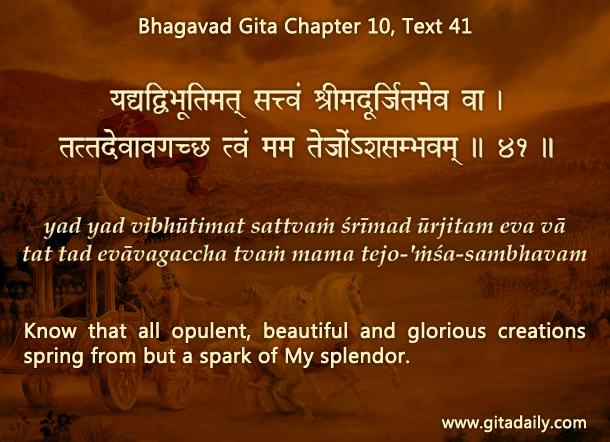The Bhagavad-gita declares that all attractive things derive their attractiveness from a spark of Krishna’s supreme attractiveness (10.41). This implies that the world we encounter with our senses is real, for it manifests the attractiveness of God, although only to a fractional degree. This world can thus be a pathway toward God. When we engage our eyes, tongue, and mind in the process of bhakti, or in the process of seva with an attitude of bhakti, those are the times we are moving through reality to reality: that is, through the physical reality of this world to the supreme reality that is Krishna.
The world is real, even though it is certainly a lower reality and a dependent reality. The world was there before we came into it by birth, and the world will be there to say goodbye to us when we leave it at death. Every night when we go to sleep, the ground under us remains firm and remains the same way when we wake up.
That which is real, in a straightforward sense, means that which exists apart from any idea thought by anyone about it, and that which would exist even when there was no one to think about it. That applies to the world we live in, and that applies also to the Lord who is the source of the world. The idea that the world is simply unreal and only the thought-world is real is just a brain-deep idea; it is not a life-deep idea. People who dismiss the world as illusory are very careful not to live according to their theories, for no one can practically function or survive by dismissing the world of our daily experiences as simply false.
We are meant to wake up to a higher reality, just as we wake up to the reality of this world every morning from our sleep. However, while waking up from sleep to the reality of the physical world happens naturally due to our biology, waking up to the higher reality has to be done conscientiously. It has to be done by engaging with the reality of this world while remembering that there is a higher reality that doesn’t just extend beyond this world, but that also encloses and embraces this world and thus encloses and embraces us.
Considering this world to be entirely unreal, or for that matter, as the only thing real, creates within us a spiritual insensibility: a numbness that prevents us from even perceiving a higher reality, let alone progressing toward it. Instead, we use our real senses to really engage with those real objects in this world that point us toward a higher reality—objects such as the sound of Krishna’s holy names and His beautiful deities and pictures. Thus, we all can progress through the lower and dependent reality of this world towards a higher reality —nay, the highest and supremely independent reality — that is Krishna.
It is at that level of realization, of spiritual awakening, that we find the highest happiness—that experience which is really worthy of the name happiness, not that which is a mere sensation that is there at one moment and frustratingly, inescapably, disappears the next moment. It is toward that higher reality that Krishna beckons us at every moment. Why delay responding to him for even one moment more?
Summary:
- The Gita declares that the world is real, and so are its objects in the sense that they exist independent of any ideas we have about their existence, and even indeed independent of our very existence.
- These objects are also real in the sense that they are a part of a lower reality that is enclosed by and embraced by Krishna, who is the highest reality and the supremely independent reality.
- By engaging our real senses with those real objects that can act as pathways toward Krishna, we all can tangibly progress towards real, everlasting happiness.
Think it over:
- In what sense is the world of our daily experience real?
- How can the world be a pathway for us toward the supreme reality?
- What is the difference between waking up to physical reality and waking up to spiritual reality?
***
10.41 Know that all opulent, beautiful and glorious creations spring from but a spark of My splendor.


Leave A Comment